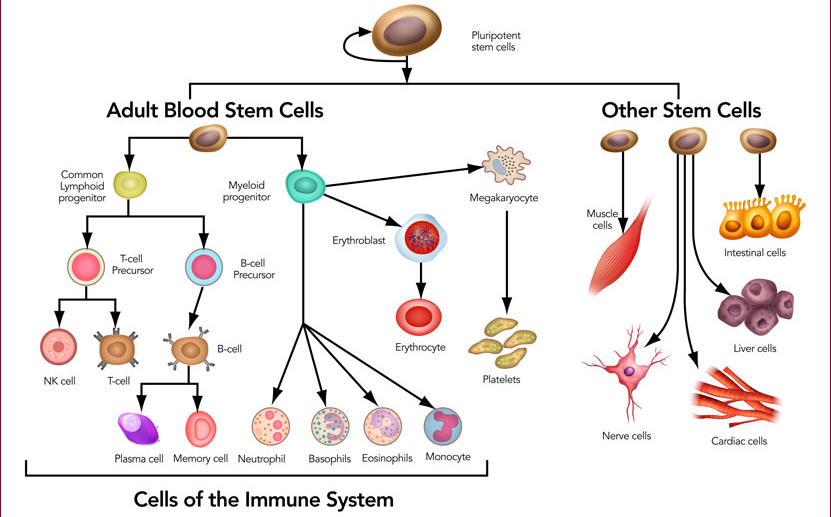
[/image][=video]
[/video]
There are many kinds of stem cells. As a whole, the term stem cell refers to a group of cells that give rise to other cells (like skin, blood, heart, and muscle cells) by reproducing and separating in response to chemical cues. Totipotent stem cells show up at the earliest phase of growth and are the only stem cells which can create embryonic stem cells and the placenta.
Bone marrow transplant (BMT) is a special treatment for individuals with specific cancers or various other illness. A bone marrow transplant includes taking cells that are normally located in the bone marrow (stem cells), filtering system those cells, and giving them back either to the contributor (person) or to one more person. The goal of BMT is to transfuse healthy bone marrow cells right into an individual after his or her own undesirable bone marrow has actually been dealt with to kill the uncommon cells.
The blood cells that make various other blood cells are called stem cells. The most primitive of the stem cells is called the pluripotent stem cell.
It is the stem cells that are needed in bone marrow transplant. The objective of a bone marrow transplant is to cure numerous conditions and sorts of cancer. When the doses of chemotherapy or radiation needed to cure a cancer cells are so high that an individual's bone marrow stem cells will be completely harmed or destroyed by the therapy, a bone marrow transplant might be required.
Perimenopause Treatment
This procedure is typically called rescue. Replace bone marrow with genetically healthy operating bone marrow to protect against even more damage from a hereditary illness process (such as Hurler's syndrome and adrenoleukodystrophy). The dangers and advantages need to be considered in a detailed discussion with your healthcare supplier and experts in bone marrow transplants before the treatment.
There are various kinds of bone marrow transplants depending upon that the contributor is. The various kinds of BMT consist of the following: The contributor is the person himself or herself. Stem cells are taken from the individual either by bone marrow harvest or apheresis (a process of collecting peripheral blood stem cells), frozen, and after that repaid to the patient after extensive treatment.
The benefactor shares the same hereditary type as the individual. Stem cells are taken either by bone marrow harvest or apheresis from a genetically matched benefactor, normally a sibling or sibling. Various other donors for allogeneic bone marrow transplants may consist of the following: A haploid-identical match is when the donor is a parent and the hereditary suit goes to least half identical to the recipient.

Matching involves keying human leukocyte antigen (HLA) cells. The antigens externally of these unique white blood cells identify the genetic makeup of an individual's immune system. There are at the very least 100 HLA antigens; however, it is believed that there are a few significant antigens that identify whether a contributor and recipient match.
Medical research is still investigating the duty all antigens play in the procedure of a bone marrow transplant. The more antigens that match, the much better the engraftment of donated marrow. Engraftment of the stem cells takes place when the given away cells make their method to the marrow and begin making new blood cells.
Medical Group
All people function with each other to give the finest chance for an effective transplant. The team consists of the following: Healthcare service providers who specialize in oncology, hematology, immunology, and bone marrow hair transplant.
Professionals who will aid you meet your nutritional demands prior to and after the transplant. Several other group participants will review you before transplantation and will provide follow-up treatment as required.

A full clinical background and physical examination are carried out, including several examinations to review the person's blood and organ features (for instance, heart, kidney, liver, and lungs). A person will typically enter into the transplant facility up to 10 days before transplant for hydration, examination, positioning of the central venous line, and other prep work.
For an allogeneic transplant, an appropriate (tissue typed and matched) benefactor should be available. Volunteer marrow donors are signed up in several national and global computer system registries.
Contributor resources available consist of: self, sibling, moms and dad or relative, nonrelated individual, or umbilical cable from an associated or nonrelated person. There are national and international computer registries for nonrelated individuals and cable blood. Some family members might be keyed in due to the wish to aid. These family members may or may not choose to have their type signed up for usage with other recipients.
Hormone Therapy in Hamtramck
Tests associated with his/her health, exposure to infections, and genetic analysis will be done to identify the level of the match. The donor will be provided directions on exactly how a bone marrow donation will be made. As soon as a suit for a person requiring a bone marrow transplant is found, after that stem cells will certainly be collected either by a bone marrow harvest.
Or by a peripheral blood stem cell collection. This is where stem cells are gathered from the circulating cells in the blood. Of the 2, outer blood stem cell contributions are now extra typical. Cord blood has currently been collected at the time of a birth and stored for later usage.
Navigation
Latest Posts
Stem Cell Therapy
Menopause Therapy around Hamtramck
Hormone Therapy